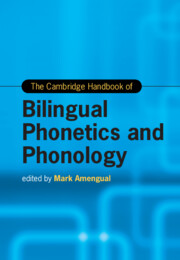Book contents
- The Cambridge Handbook of Bilingual Phonetics and Phonology
- Cambridge Handbooks in Language and Linguistics
- The Cambridge Handbook of Bilingual Phonetics and Phonology
- Copyright page
- Dedication
- Contents
- Figures
- Tables
- Contributors
- Acknowledgments
- Introduction Bilingual Phonetics and Phonology
- Part I Approaches to Bilingual Phonetics and Phonology
- Part II Theoretical Models of Bilingual Phonetics and Phonology
- 7 The Perceptual Assimilation Model: Early Bilingual Adults and Developmental Foundations
- 8 The Second Language Linguistic Perception Model
- 9 The Automatic Selective Perception Model
- 10 The Ontogeny Phylogeny Model
- 11 Bilingual Speech and Exemplar Theory
- Part III The Phonetics and Phonology of the Bilingual Child
- Part IV The Phonetics and Phonology of the Bilingual Adult
- Part V The Diversity of Bilingual Speakers
- Part VI Variables and Outcomes of Bilingual Speech
- Index
- References
7 - The Perceptual Assimilation Model: Early Bilingual Adults and Developmental Foundations
from Part II - Theoretical Models of Bilingual Phonetics and Phonology
Published online by Cambridge University Press: 14 November 2024
- The Cambridge Handbook of Bilingual Phonetics and Phonology
- Cambridge Handbooks in Language and Linguistics
- The Cambridge Handbook of Bilingual Phonetics and Phonology
- Copyright page
- Dedication
- Contents
- Figures
- Tables
- Contributors
- Acknowledgments
- Introduction Bilingual Phonetics and Phonology
- Part I Approaches to Bilingual Phonetics and Phonology
- Part II Theoretical Models of Bilingual Phonetics and Phonology
- 7 The Perceptual Assimilation Model: Early Bilingual Adults and Developmental Foundations
- 8 The Second Language Linguistic Perception Model
- 9 The Automatic Selective Perception Model
- 10 The Ontogeny Phylogeny Model
- 11 Bilingual Speech and Exemplar Theory
- Part III The Phonetics and Phonology of the Bilingual Child
- Part IV The Phonetics and Phonology of the Bilingual Adult
- Part V The Diversity of Bilingual Speakers
- Part VI Variables and Outcomes of Bilingual Speech
- Index
- References
Summary
The Perceptual Assimilation Model (PAM) accounts for how native-language (L1) experience shapes speech perception. According to PAM, infants develop phonological categories by attuning to the critical phonetic features that set phonological categories apart (phonological distinctiveness) and to the phonetic variability that defines each category (phonological constancy).The effects of L1 attunement on perception can also be seen in adults. PAM generates predictions about discrimination accuracy for non-native contrasts by comparing how the non-native phones are perceived in terms of L1 phonological categories. The extent to which perception might be altered further by experience with a second language (L2) is outlined by PAM-L2. While PAM has focused on L1 attunement in monolinguals, and PAM-L2 on L2 acquisition in adulthood, their principles also apply to early bilingual language acquisition. In this chapter, we will consider the various contexts of acquisition and language use in early bilinguals to sketch out how experience with more than one native language shapes perception and how childhood L2 acquisition might modify the emerging phonological system.
Keywords
- Type
- Chapter
- Information
- The Cambridge Handbook of Bilingual Phonetics and Phonology , pp. 147 - 172Publisher: Cambridge University PressPrint publication year: 2024

